Through this article we’ll be taking a look at the common question, Can Hogweed Burn Your Skin? I always find it really interesting to see people’s reactions during a foraging course, as we pull up next to a fabulous patch of young succulent Common Hogweed Shoots and I go on to tell everyone that they are one of my favourite wild edible plants.
Shock Horror.
The first thing we must cover is, of course, is the potential these plants have of burning your skin. Questions like ‘are they safe?’ or ‘do you need to wear gloves when picking?’ come up first – so let’s have a little look in to this plant.
There’s two main types of Hogweed:
I’d like to start by saying I’ve personally picked Common Hogweed for over 8 years without wearing gloves and have never had any ill effects from doing so.
However both plants are phototoxic, they contain amounts of furocoumarins which alter then melanin present in your skin and actually stop your skin from having the ability to protect itself from UV rays given off by certain lights and the sun.
Common hogweed contains very small amounts of this within its sap, even less in the sap of the immature shoots and I’ve never had an issue with the sap of common hogweed. Saying that, I always advise people with sensitive skin to wear a pair of gloves (standard gardening gloves will work) when picking common hogweed, especially if it’s a very sunny day.
Giant hogweed on the other hand contains fairly high levels of this chemical and can dispense the chemical without the need to break the stem and extract the sap – simply brushing up against the hairs or needles of the stalk of this plant is enough to get the juice on you. It is therefore strongly advised to stay well clear of giant hogweed. The main issue arises with this plant when somebody has decided to do some strimming on a hot day. Of course the top comes off (suns out, guns out comes to mind) and strimming commences, in the process of strimming, juice is sprayed all over the individuals body and that skin is exposed to UV from sun light for a period of time whilst strimming continues. These later burn and blister (the Daily Sun magazine gets a lovely picture and shocking story). The effects of this type of chemical phototoxin can have effects on your skins melanin for 7 years, meaning that the effected area has to be covered up for a further 7 years before being exposed to sunlight safely – otherwise burning will occur again as your skin has little to no protection from UV light.
At this point I’d also like to add that although I don’t advise it, I’ve happily eaten Giant hogweed shoots, boiled in two changes of water and it was as tasty as common hogweed shoots.
To answer the original question there is potential that the juice of common hogweed could leave to burning of the skin and – Yes Giant hogweed can definitely lead to the burning of your skin. To keep yourself safe check out the identification of both plants by following the link below.
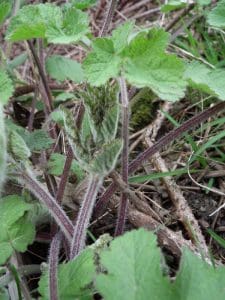
For more information on how to identify Common Hogweed Click here.
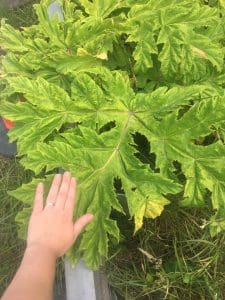
For more information on how to identify Giant Hogweed Click here.
Physical Characteristics of Common Hogweed
Hogweed is a herbaceous perennial or biennial plant that can grow from 50-120cms in height. The main stem rises from a large reddish rhizomatous root, it is striated or ribbed, hollow, and has bristly hairs all over.
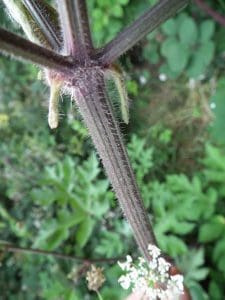
Leaves
The leaves can reach a length of 55cms in length, they are very pinnate, hairy, and serrated, they are divided into 3-5 lobed sections, the edges are typically round, unlike giant hogweed which are always extremely pointed.
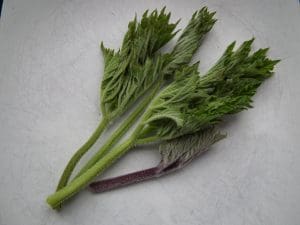
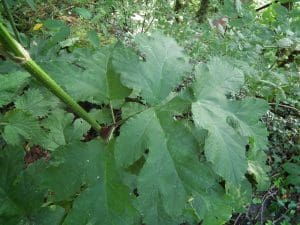
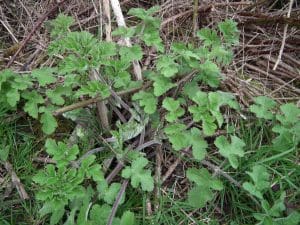
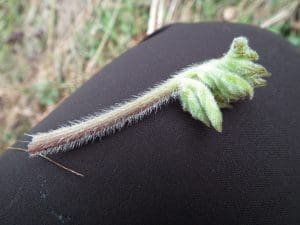
Flowers
Hogweed has white to pinkish flowers, displayed in large umbels (umbrella looking) up to 25cms, each containing 15-30 individual flowers, these individual flowers contain 5 petals.
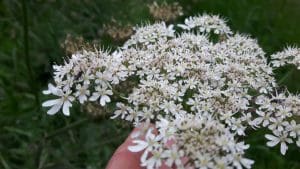
Seeds
The seeds are winged and flattened contained in pods with rounded edges, up to 1cm long.
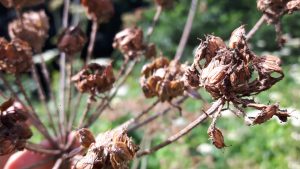
Edible Use:
Root: edible, grated, Lacto fermented, alcohol infusions
Stem: steamed, chopped in salads, battered, fried, on pizzas and omelets
Leaves: soups, dried as a seasoning
Fruit/seeds: as cardamom in cakes, cookies, shortbread, chutney, rice, curries, as a celery salt, infused with alcohol.
Herbal
It’s referenced that the seeds have been used medicinally in the past, being heated in oil and applied to the skin for shingles; also a decoction of the seeds was to be used for aiding a running ear.
Physical Characteristics for Giant Hogweed
Leaves
The leaves are large, shiny and deeply lobed. They look intimidating and scary. Deep green in colour, their upper surface is hairless. When fully grown they can be up to 1.5 metres long and almost as wide.
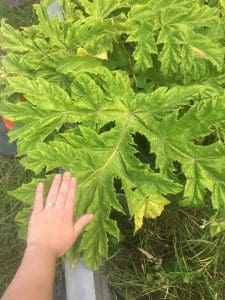
Stems
The stems are hollow, green but with age they develop purple or reddish blotches with thick dark hairs. They can grow up to 4.5 metres tall with stems as thick as 10cm.
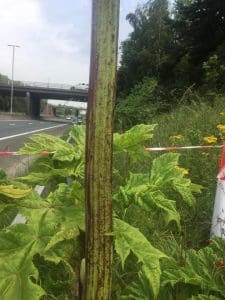
Flowers
The individual flowers are tiny, white and have 5 petals, they appear as an umbel at the tops of the stems. The flower head looks like the spokes of an umbrella and are lilac to purple in colour. There can be between 50-150 spokes per flowering head. After flowering the plant produces a mass of seeds, up to 50,000 per plant!
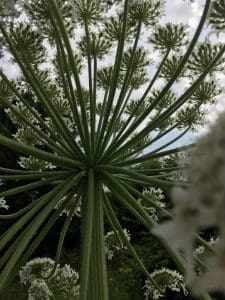
Habitat
Damp environments, river banks, meadows and especially canal systems.
Known Hazards
This plant is a serious menace and all foragers should be aware of it. Some call it Britain’s most dangerous plant and The Daily Star have dubbed it ‘Killer Weed’
It is an offense under the Wildlife and Countryside Act 1981 to plant or cause giant hogweed to grow in the wild and in some areas there is a legal requirement to report sighting to DEFRA.
All parts of the plant contain furanocoumarins which are powerful phototoxins, contact causes your skin to lose its protection against the sun and leads to phytophotodermatitis, a serious skin inflammation. Every time this area of skin is exposed to sunlight for up to 8 years the burns come back.
If the saps gets into your eyes it can cause permanent sight loss.
If you do come into contact with the plant you are advised to wash the area well with soap and water and to avoid sunlight for 48 hours.
Could be Confused with…
It is very closely related to Common Hogweed (Heracleum sphondylium) and they do look alike from a distance.
Fully grown Common Hogweed grows up to 2metres tall whereas Giant can reach 4-5 metres, where the plants have grown there are normally last year’s skeletal remains which can be helpful.
The tops of leaves of Giant Hogweed are smooth whereas Common Hogweed has hairy leaves.
The flowers of Giant Hogweed are also much larger and can be up to 1.5 metres in diameter.
Extra notes from the Foragers
A non-native species, it was bought to the UK from the Caucasus Mountains in the 19th century as an ornamental and was grown at Kew gardens. It was added to Kews seed bank in 1817 and it was first recorded in the wild only 11 years later.





